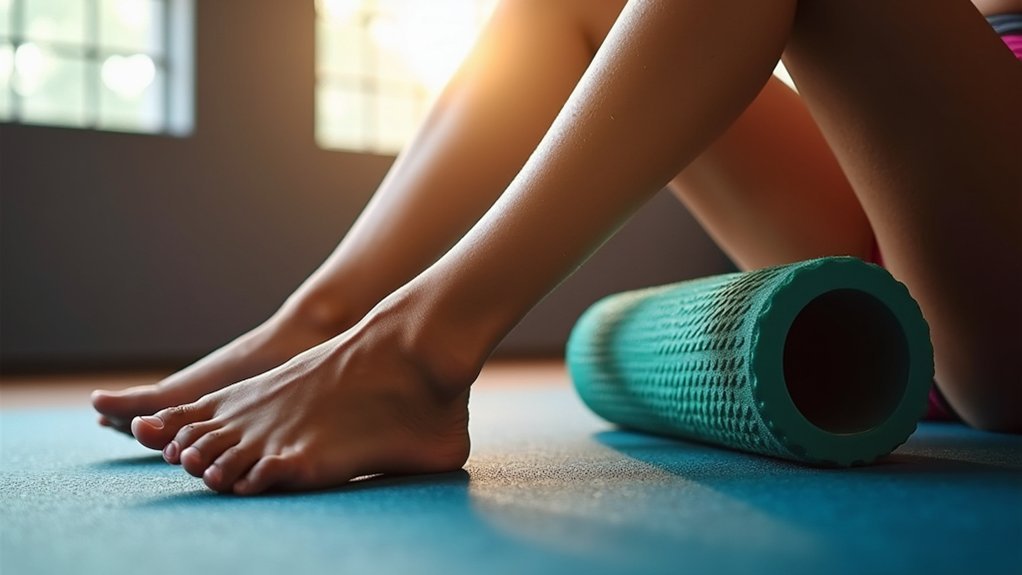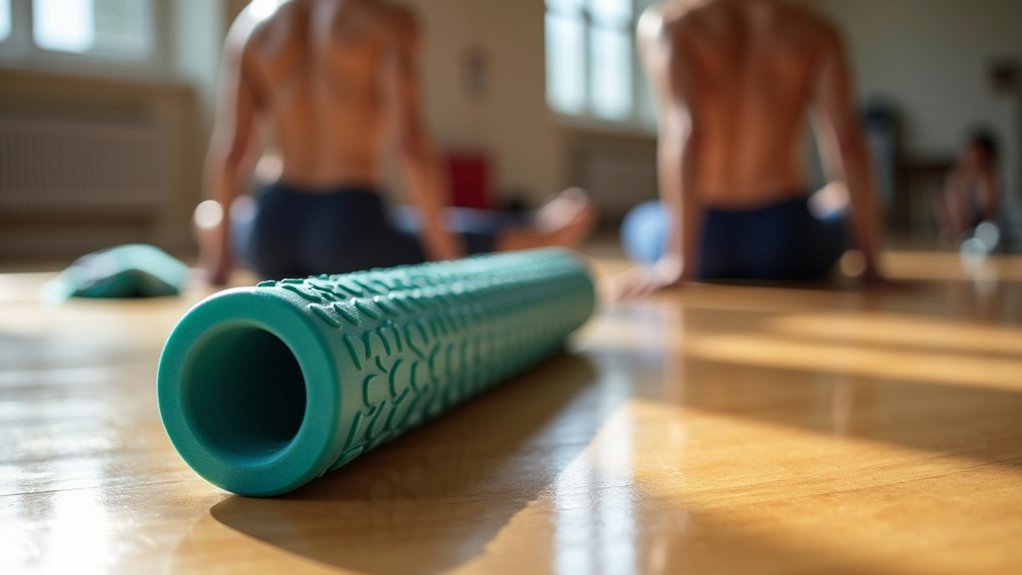Foam rolling after jump sessions accelerates your recovery by enhancing circulation, removing inflammatory waste, and breaking up muscle knots. You’ll reduce delayed onset muscle soreness in critical jumping muscles like quads, hamstrings, and calves while restoring mobility in ankles, knees, and hips. This practice can improve your sprint performance by 0.7% and flexibility by 4-5%. The science behind these benefits reveals why serious jumpers never skip this essential recovery step.
The Science Behind Foam Rolling for Jumpers

While many athletes incorporate foam rolling into their routines instinctively, the science behind its effectiveness for jumpers is particularly compelling. Research shows foam rolling can improve sprint performance by 0.7% and flexibility by approximately 4-5%, directly benefiting your jumping mechanics.
When you use cylindrical foam rollers for self-myofascial release, you’re triggering neural adaptations that enhance stretch tolerance and range of motion. This matters for jumpers because increased flexibility translates to better force generation during takeoff. For optimal results, aim to perform 3-5 sets of 20-30 second repetitions at least three times weekly.
The evidence is especially strong regarding DOMS reduction. As a jumper, managing delayed onset muscle soreness is vital for consistent training. Foam rolling helps alleviate muscle tenderness and reduces stiffness in muscles and tendons, allowing you to maintain peak performance levels between jump sessions.
How Foam Rolling Accelerates Recovery After Trampoline Workouts
After an intense trampoline session, your muscles deserve focused recovery care that foam rolling uniquely provides. This technique enhances circulation, delivering essential nutrients to damaged tissues while removing inflammatory waste products that cause soreness.
You’ll experience three key benefits when you incorporate foam rolling post-jump:
- Immediate relief as the roller breaks up tight muscle knots, releasing tension that accumulated during your high-impact jumps.
- Restored mobility in your ankles, knees, and hips that endured repetitive landing forces, preparing you for your next session.
- Reduced DOMS intensity as the mechanical pressure stimulates blood flow to your quadriceps, hamstrings, and calves.
Consistent foam rolling not only speeds up your recovery time but also maintains your performance levels between workouts, keeping you bounce-ready. When combined with proper sleep quality, this recovery technique becomes even more effective, as your body performs significant repair processes during rest periods.
Targeting Key Muscle Groups for Rebounding Athletes

Rebounding athletes need to focus on specific muscle groups that bear the brunt of jump-related stress and impact forces.
Your quadriceps require attention to enhance knee extension and optimize landing forces, preventing overuse injuries like patellar tendinopathy. Controlled pressure through body weight during foam rolling helps release tight quadriceps tissue effectively.
Don’t neglect your calves, which need relief from plantar flexion strain and improved ankle mobility for better takeoffs.
Your glutes deserve focus to enhance hip stabilization and power transfer while reducing lumbar strain.
Hamstrings benefit from foam rolling to improve eccentric control during landings and prevent tendinopathy.
Finally, address your hip flexors to restore proper extension range and reduce anterior impingement that develops from repetitive jumping.
Optimal Timing: When to Foam Roll After Jump Sessions
The timing of your foam rolling directly influences your jump recovery, with research showing distinct benefits across immediate post-exercise, 24-hour, 48-hour, and 72-hour windows.
You’ll maximize DOMS reduction by rolling within 30 minutes after jumping, while performance metrics like sprint times and broad jumps benefit most from additional sessions at the 48-hour mark.
For nighttime training sessions, consider pre-sleep rolling to enhance overnight recovery processes and maintain next-day performance capabilities. However, current research indicates no significant differences in recovery outcomes between 1-minute and 2-minute foam rolling durations, suggesting that consistency may be more important than duration.
Immediate vs. Delayed Recovery
While athletes often debate the ideal timing for foam rolling, research indicates distinct benefits for both immediate and delayed application after jump sessions. Your recovery strategy should consider both windows for best results.
Immediate post-jump rolling (within 30 minutes) primarily addresses acute pain mitigation and helps maintain performance levels, though it shows limited impact on jump height recovery.
Next-day rolling (24-48 hours post-session) targets formed myofascial restrictions and supports longer-term recovery phases. Incorporating foam rolling regularly can significantly reduce injury risk while improving overall mobility after repetitive jumping movements.
- Immediate rolling – Picture yourself spending 1-2 minutes per muscle group during cooldown, focusing on quads and calves.
- Next-day rolling – Visualize a morning session targeting any restricted areas with slower, more deliberate pressure.
- Combined approach – Imagine integrating both timeframes for thorough recovery, especially after particularly intense sessions.
Morning or Evening Rolling
Deciding whether to foam roll in the morning or evening after jump sessions isn’t just a matter of convenience—it’s a strategic recovery choice that impacts your performance trajectory. Your timing should align with specific recovery goals.
| Timing | Primary Benefit | Best For |
|---|---|---|
| Morning | Enhanced circulation & reduced stiffness | Preparing for same-day workouts |
| Evening | Muscle recovery & tension relief | Processing day’s training stress |
| Post-Exercise | Immediate inflammation control | Jumpstarting recovery process |
Evening rolling offers superior benefits for jump recovery, particularly for reducing DOMS and promoting relaxation that enhances sleep quality. Morning sessions excel at preparing muscles for upcoming workouts by improving flexibility and range of motion. Recent studies demonstrate that consistent foam rolling contributes to overall flexibility improvement without diminishing athletic performance metrics. Remember that consistency trumps perfect timing—regular rolling at any time delivers better results than sporadic sessions, even if ideally timed.
Pre-Sleep Rolling Benefits
Strategically timing your foam rolling session before sleep creates a powerful recovery window that leverages your body’s natural repair mechanisms.
This approach capitalizes on peak growth hormone secretion and collagen synthesis that occur during early sleep cycles, accelerating tissue repair after intense jumping workouts.
Rolling 30-60 minutes before bedtime stimulates your parasympathetic nervous system, reducing muscle tension and preparing your body for restorative sleep.
You’ll experience enhanced recovery metrics including preserved jumping performance and reduced DOMS within 72 hours post-exercise.
Properly aligning new collagen fibers with existing muscle tissue through pre-sleep foam rolling reduces the formation of myofascial adhesions that commonly develop after jump training.
- Target quadriceps, hamstrings, and calves for 60-90 seconds each using medium-density rollers
- Roll multi-directionally to address fascial cross-linkages from explosive jumping movements
- Combine with gentle stretching to maximize range of motion benefits, particularly in ankle dorsiflexion
Performance Benefits Beyond Simple Recovery
Your foam rolling routine after jump sessions doesn’t just reduce soreness—it actively preserves your ability to generate power in subsequent workouts.
Research shows that proper post-jump foam rolling helps maintain your vertical jump height potential even when training frequently.
You’ll likely experience more consistent performance across training sessions when foam rolling becomes a regular part of your recovery protocol. When combined with dynamic warm-up routines, foam rolling has been shown to enhance power, agility, and strength performance in physically active individuals.
Power Output Maintenance
While foam rolling is often viewed primarily as a recovery tool, its benefits for maintaining power output during jump sessions extend far beyond simple muscle relief.
Research shows foam rolling enhances anaerobic performance by increasing peak torque production during explosive movements, helping you maintain force through improved quadriceps activation.
Unlike static stretching, foam rolling won’t compromise your power metrics in subsequent sessions, making it ideal for high-intensity jump training.
It’s comparable to active warm-ups for augmenting leg power while reducing post-exercise muscle tenderness. A cross-over study with 21 male athletes demonstrated that both foam rolling and active warm-up protocols produced significant increases in peak torque measurements.
- Force sustainment – Preserves your ability to generate maximum power across multiple jump sets
- Quadriceps activation – Maintains neural drive to primary jumping muscles
- Tenderness reduction – Decreases performance-limiting soreness between high-intensity efforts
Jump Height Preservation
Beyond its recovery benefits, foam rolling plays an essential role in preserving jump height during intensive training cycles. Unlike static stretching, which can temporarily reduce power output, foam rolling improves your range of motion without compromising performance capabilities.
When you regularly incorporate foam rolling, you’re facilitating fascial layer liberation that enhances explosive movements critical for jumping. By targeting jump-specific muscles like calves and quadriceps, you’ll maintain neuromuscular activation patterns essential for peak vertical performance.
The physiological benefits extend beyond immediate effects—reduced muscle soreness and improved blood flow contribute to sustained jump height over time. Your perceived jumping ability may even improve as foam rolling enhances muscle activation and jump mechanics.
For athletes engaged in repeated jump sessions, this maintenance strategy prevents the cumulative fatigue that typically diminishes vertical performance. Studies show that foam rolling can increase muscle force output immediately after application, providing an advantage for subsequent jumping exercises.
Preventing Injuries Through Regular Foam Rolling

Regular foam rolling serves as a powerful tool in any athlete’s injury prevention arsenal, especially after high-impact jump sessions.
By incorporating this practice after you’ve finished jumping, you’ll considerably reduce muscle fatigue and soreness while enhancing flexibility—three vital factors in preventing strain injuries.
When you foam roll consistently, you’re not just addressing immediate discomfort but building long-term resilience against injuries through:
- Increased range of motion – Your muscles become more pliable, reducing the risk of tears during explosive movements
- Enhanced neuromuscular recovery – Your body bounces back faster, preventing compensatory movements that lead to injury
- Improved posture alignment – Your biomechanics remain optimal, distributing impact forces more effectively
This preventative approach works best when used both before and after your jump training sessions. Using varying density levels of foam rollers can help you adjust the intensity based on your specific recovery needs.
Foam Rolling Techniques Specifically for Trampoline Enthusiasts
Trampoline enthusiasts face unique muscular demands that require specialized foam rolling techniques to maximize performance and recovery.
Focus on your quadriceps and hip flexors using oscillatory movements in a 2-4 inch range to release tension built up from repetitive jumping.
Opt for a medium-density roller with a 36-inch length to accommodate full-body positioning. Remember that selecting the appropriate foam roller is crucial for effective recovery, as one that’s too dense may cause pain rather than beneficial discomfort.
When addressing hamstrings and calves—critical for safe landings—use the exhale-on-pain principle when encountering trigger points.
Incorporate 45-degree angled positioning to target oblique chains engaged during aerial twists.
Vary your tempo: slow rolls (~1 inch/second) for chronic tightness, faster for warm-ups.
Follow rolling with dynamic leg swings within 2 minutes to capitalize on your increased range of motion.
Combining Foam Rolling With Other Recovery Methods
You’ll maximize recovery by combining foam rolling with complementary methods like stretching, sports massage, and proper nutrition after intense jump sessions.
Start with foam rolling to release tight muscles, follow with gentle stretching, and include active recovery movements to create a thorough restoration sequence.
This balanced approach addresses multiple aspects of recovery—mechanical tissue work, flexibility enhancement, and metabolic support—giving your jumping muscles the complete care they need.
Both approaches will benefit your range of motion as studies indicate similar ROM increases can be achieved through either foam rolling or stretching as part of your recovery routine.
Amplifying Recovery Effects
While foam rolling alone delivers significant recovery benefits, combining it with complementary techniques creates powerful synergistic effects that can dramatically accelerate your post-jump recovery.
By integrating foam rolling into a thorough recovery protocol, you’ll enhance blood circulation, reduce inflammation, and maintain muscle activation between training sessions. Foam rolling provides self-myofascial release to sore muscles, improving blood flow and nourishing muscles after intense jump workouts.
- Roll + Contrast Therapy: Spend 10 minutes foam rolling your quads and calves, then immediately alternate between 1-minute cold shower and 2-minute warm shower cycles to boost circulation by up to 75%.
- Roll + Compression: After rolling your legs, slip on compression garments to sustain improved blood flow for hours while you sleep.
- Roll + Anti-Inflammatory Nutrition: Pair your rolling session with tart cherry juice to attack muscle soreness from multiple angles.
Strategic Method Sequencing
Building on these synergistic effects, the strategic sequencing of recovery methods can transform your post-jump rehabilitation process from good to exceptional. Combining foam rolling with cryotherapy and stretching creates a thorough approach that targets multiple aspects of recovery simultaneously. According to research, foam rolling recovery shows significant benefits in reducing muscle damage indices comparable to cold water immersion.
| Recovery Combination | Benefit | Emotional Impact |
|---|---|---|
| Foam Rolling + Cryotherapy | Reduced muscle damage indicators | Relief from nagging soreness |
| Foam Rolling + Stretching | Enhanced fascial efficiency | Freedom of movement restored |
| Foam Rolling + Active Recovery | Increased power output | Confidence in your next performance |
You’ll maximize efficiency by timing these combinations strategically. For ideal DOMS reduction, implement your sequence within 48 hours post-jump session. This personalized approach allows you to tailor recovery to your specific needs, ensuring you’re ready for your next training session with minimal lingering fatigue.
Balanced Modality Approach
The balanced modality approach emerges as the cornerstone of effective post-jump recovery, transforming isolated techniques into an all-encompassing healing system.
When you combine foam rolling with complementary recovery methods, you’ll maximize your body’s repair potential and minimize downtime between training sessions.
- Foam Rolling + Ice Massage – Visualize the dual action of pressure breaking up adhesions while cold therapy calms inflammation, creating a powerful one-two punch against soreness.
- Self-Myofascial Release + Active Recovery – Picture gentle cycling or swimming movements flushing metabolic waste from tissues while foam rolling targets specific trigger points.
- Rolling + Professional Massage – Imagine maintaining daily tissue quality with your roller, then experiencing deeper release through targeted professional techniques during weekly sessions. This combination enhances blood circulation throughout the body, optimizing the removal of toxins while improving nutrient delivery to recovering muscles.
Common Mistakes to Avoid in Your Post-Jump Recovery
Despite the proven benefits of foam rolling after jump sessions, many athletes undermine their recovery potential by committing several critical errors. You might be rushing through your foam rolling routine without targeting key muscles like quadriceps and hamstrings, or applying excessive pressure too quickly.
Don’t overlook the importance of proper nutrition—hydration, protein intake, and anti-inflammatory foods greatly impact recovery effectiveness. Likewise, inadequate sleep disrupts your body’s natural repair processes.
Time allocation is another pitfall; you’re shortchanging yourself when you don’t dedicate sufficient minutes to proper technique or establish consistent recovery routines. A proper foam rolling session should last approximately 5 to 10 minutes to effectively release muscle tension and improve recovery.
Remember that foam rolling works best as part of a thorough approach including stretching, active recovery methods, and occasional complementary techniques like compression therapy or ice baths.
From Occasional Jumper to Professional: Recovery Needs Across Levels
Recovery needs vary dramatically depending on your jumping experience level, with each stage of development requiring tailored approaches to foam rolling techniques and routines.
As beginners, you’ll benefit from standard-density rollers and basic post-exercise routines to manage soreness. Studies show that as little as 2 minutes of foam rolling can provide significant benefits for novice jumpers.
Intermediate jumpers should focus on flexibility enhancement and preventative maintenance, while professionals need advanced techniques and customized recovery protocols.
- Beginner: Picture yourself spending 5-10 minutes with a soft roller after practice, gently working through major muscle groups while breathing deeply.
- Intermediate: Visualize targeted rolling on specific jumping muscles (calves, quads, hamstrings) using medium-density rollers for 15 minutes.
- Professional: Imagine an all-encompassing 30-minute routine using multiple specialized tools (dense rollers, balls, bars) with precise technique to address individual needs.
Tracking Your Progress: Measuring the Impact of Foam Rolling
Measuring your foam rolling progress requires both objective metrics and subjective assessments to determine its true impact on your jump performance.
Track your 30-meter sprint times to quantify the typical 3.1% speed improvement post-rolling, and monitor broad-jump distances to assess power retention.
Use a visual analog scale to document your perceived muscle soreness, which typically decreases by 6% after rolling.
For more precise data, pressure-pain algometry can quantify changes in muscle tenderness thresholds, especially in quadriceps and hamstrings.
Pay attention to strength maintenance during high-repetition exercises and T-test times for agility recovery.
Though rolling shows only trivial direct effects on jump height (-0.2%), its real value lies in preserving overall athletic capacity throughout your training cycle, particularly when using high-density cylindrical rollers.
Regular foam rolling three times per week will help you maintain consistent muscle length and flexibility, which directly contributes to injury prevention during intensive jump training.
Frequently Asked Questions
Can Foam Rolling Replace Stretching Completely for Jumpers?
You can’t completely replace stretching with foam rolling. While foam rolling targets muscle tension, stretching uniquely enhances flexibility. For ideal results as a jumper, you’ll benefit from using both methods in combination.
How Long Should a Foam Roller Last Before Replacement?
Your foam roller should last 6 months to 2 years depending on usage frequency and material quality. Replace it when you notice deformation, decreased firmness, or loss of surface texture affecting performance.
Are Vibrating Foam Rollers Worth the Extra Cost?
For most users, vibrating foam rollers aren’t worth the extra cost. You’ll get slightly better ROM benefits, but the performance gains are minimal and they’re less portable than standard rollers, requiring power sources.
Do Different Foam Roller Densities Affect Recovery Results?
Yes, foam roller density affects your recovery results. High-density rollers reach deeper tissues for intense relief, while medium-density rollers balance comfort and effectiveness. Choose based on your pain tolerance and recovery needs.
Can Foam Rolling Help With Existing Jump-Related Injuries?
Yes, foam rolling can help with your existing jump-related injuries by reducing pain, breaking up muscle adhesions, restoring mobility, and improving tissue elasticity—all while supporting your rehabilitation process through enhanced blood flow.
In Summary
Don’t underestimate the power of foam rolling in your jumping routine. By dedicating just a few minutes after your sessions, you’ll experience faster recovery, reduced soreness, and improved performance over time. Listen to your body, target the right muscle groups, and make foam rolling a non-negotiable part of your training. Your future jumping performance and injury prevention depend on the recovery habits you establish today.





Leave a Reply